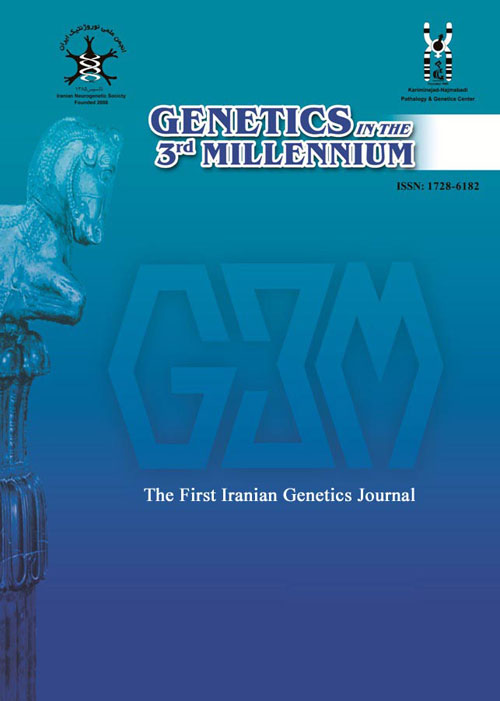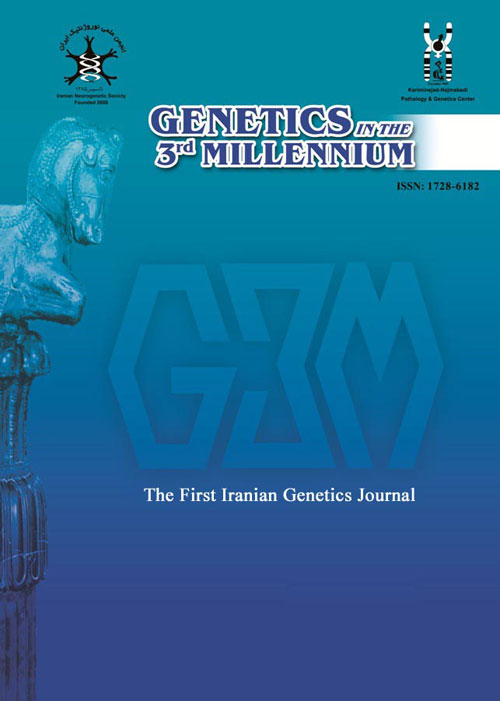فهرست مطالب

Genetics in the Third Millennium
Volume:14 Issue: 2, Spring 2016
- تاریخ انتشار: 1395/03/18
- تعداد عناوین: 8
-
-
Pages 4234-4241ipaD gene is amongst key genes in Shigella invasion, known as an antigen. PA20 protein of Bacillus anthracic can be separated from native PA protein during the infection and can be found in the serum of the infected patients and make it possible to diagnose the disease. CTxB, a known immune adjuvant, enhances the immunogenicity and is mainly used for the production of recombinant vaccines as a booster for immunization with antigen. In order to produce a vaccine with the immunogenic properties for the diseases, shigellosis and anthrax, different combinations of three ipaD, PA20 and CTxB genes were studied by bioinformatic tools in terms of their stability and similarity to the native proteins that are essential for their accurate performance. The aim of the present study was to introduce the best combination of the three antigens (ipaD, PA20 and CTxB) such that, when they are fused together, have a minimum effect on their structure and activity. Secondary and tertiary structures of proteins derived from different combinations of two or three proteins of ipaD, PA20 and CTxB were studied by MODELLER and PSIPRED software and the stability and lifespan of the fused genes were surveyed using ProtParam software. Analysis of data obtained from different combinations of ipaD, PA20 and CTxB genes by PSIPRED, ProtParam and MODELLER software showed that the best triple combination was PA20-CTxB-ipaD and the best of dual combinations was PA20-ipaD. When a protein combines with other proteins, the three-dimensional structure and physicochemical characteristics may dramatically change. According to the results of the present study, PA20 showed a strong stability, while ipaD showed a poor stability. Furthermore, all proteins in PA20- CTxB-ipaD combination had maintained their stability and this fusion can be used furthermore for vaccine design.Keywords: Anthrax, Bioinformatics Analysis, Shigellosis, Vaccine Design
-
Pages 4242-4249One of the important mechanisms utilized by the plant growth promoting Rhizobacteria (PGPR) is lowering of ethylene levels by the 1-aminocyclopropane-1-carboxylic acid (ACC) deaminase enzyme. The mechanism facilitates plant growth and development in the stress conditions. PGPR containing ACC deaminase can promote plant growth under stress and overcome the harmful effects. The study aimed to screen and identify the ACC deaminase producing rhizobacteria isolated from the soils of different regions in Iran. Fifty-seven isolated strains of rhizobacteria were cultured in the M9 medium with two different nitrogen sources (contains ACC and NH4Cl), in two replications. The control treatment was nitrogen free M9 medium. In this study, canola seeds, Sari Gol cultivar, were also inoculated with the ACC deaminase producing rhizobacteria for evaluating their effects on the shoot and root elongation during 5 days germination based on a completely randomized design with three replications. Finally, the best ACC deaminase producing rhizobacteria was identified by the sequencing of 16s rDNA gene. Results showed that just 8 isolated rhizobacteria strains (out of 57) produced ACC deaminase, of which Cma3 and Wah3 had the greatest effects on the stem and root length, respectively. Cma3 and Wah3 were identified as Klebsiella and pseudomonas genus, respectively. The identified strains can be useful for the crop growth in stress conditions.Keywords: Rhizobacteri, ACC deaminase, Brassica napus
-
Pages 4250-4255Bovine ephemeral fever (BEF) is an acute epidemic disease in cattle and water buffalo, spanning tropical and subtropical zones of Asia, Australia, and Africa. In recent years, BEF has been distributed in many provinces of Iran and caused economic losses. In this study the sequence encoding the G1 epitope of bovine ephemeral fever virus (BEFV) G glycoprotein was amplified by PCR, ligated into the prokaryotic expression vector, pMAL-c2X, and subsequently cloned into Rosetta strain of Escherichia coli. After being induced with Isopropyl β-D-1-thiogalactopyranoside, SDS-PAGE analysis showed that a protein of 58 kDa molecular weight, consistent with the expected molecular weight of maltose binding protein-G1 fusion protein, was expressed. Also, dot blot analysis confirmed that the expressed protein has specifically reacted with an anti-BEFV mouse serum. In conclusion, the results indicate that the recombinant G1 epitope expressed in this study could be used as a coating antigen to develop an ELISA for bovine ephemeral fever diagnosis.Keywords: Bovine ephemeral fever virus, Escherichia coli, Gene expression, G1 epitope
-
Pages 4256-4261Optimization of the condition for PCR-directed sequencing of microsatellites poly Adenine (A) length polymorphisms is more difficult and sensitive compared with other common sequences. Replication slippage may occur for polymerase enzyme during microsatellite amplification and direct sequencing of these PCR products will be challenging for heterozygote samples. So, the aim of this study is to introduce optimal condition for amplification of microsatellites poly (A) length polymorphisms such as variation of poly(A) at the 3′-end of the vitamin D receptor (VDR) gene. In this study firstly, we analyzed various types of microsatellite sequences by in silico method to select a short microsatellite sequence which has various alleles with a little length difference. Finally, VDR poly(A) microsatellite was selected. Amplification of this locus was optimized by applying hot-start PCR using gradients of temperature, DMSO, MgCl2, Taq polymerase, and primers concentration. Crush and soak method was used for DNA extraction of alleles in heterozygote samples from polyacrylamide gel. PCR products were analyzed by using single-strand conformation polymorphism and PCR-direct sequencing. Our observations showed that hot-start PCR was optimized in the concentration of 0.2 mM of primers, 0.8mM of MgCl2 and 1.75 unit of Taq polymerase in 25 μl PCR mixtures. These optimal conditions lead to remove Taq polymerase slippage and non-specific PCR product. Considering the possible errors in amplification and analysis of microsatellite, the presented method in this study could be an efficient strategy in analysis of these sequences.Keywords: Microsatellite Repeats, Polymerase Chain Reaction, Short Sequence Repeats, Polymorphism, Single, Stranded Conformational
-
Pages 4262-4269Potato Virus Y (PVY) is one of the most important pathogenic agents that reduce the yield and quality of tobacco (Nicotiana tabacum L.). DNA-based molecular markers are valuable tools for identifying germplasm in gene banks, assessing kinship ties, and doing marker-assisted selection (MAS) for resistance to pests, diseases, and some crop traits of interest. This work presents the results of association analysis for resistance to PVY with SSR markers. A total number of 66 alleles were detected using 26 SSR primer pairs on 90 oriental-type tobacco genotypes with an average of 2.54 alleles per locus. A model-based Bayesian approach was used to subdivide 90 tobacco genotypes into three subgroups. Approximately 5.85% of the 325 SSR locus pairs showed a significant level of linkage disequilibrium (LD) (PKeywords: Genetic Association Studies, Linkage Disequilibrium, Microsatellite Markers, Potyvirus, Tobacco
-
Pages 4270-4277The objective of the present study was to evaluate the genetic structure and diversity of 16 generations of native fowls of West Azerbaijan Province, Iran using the pedigree data collected between 1994 and 2012. Inbreeding coefficient (F), pedigree completeness index (PCI), parameters of the probability of gene origin and other parameters related to the genetic structure were estimated using the pedigree data of 51125 chickens. The mean PCI for up to 3 and 16 generations was 0.798 and 0.365 in the whole population, and 0.951 and 0.448 for the inbred population respectively, showing the sufficient depth of the pedigree and higher amounts of PCI for the inbred population. The total number of animals in 16 generations was 51125 chickens (F=3.07%); and the number of sires and dams was 1352 (F=2.247%) and 6863 (F=2.71%), respectively. The number of inbred chickens, sires, and dams in the population was 40751, 634, and 4429, respectively. Despite the large number of inbred animals in the population, the inbreeding average was not so high in different generations. Thus, it may be concluded that there is a suitable potential for line-crossing to help with maintaining genetic diversity in the population. The highest percentage of line-crossing was observed in the 6th (15.2%), 8th (13.81%) and 10th (10.71%) generations and its lowest percentage was in the 12th generation (1.59%). All parameters of the probability of gene origin had a decreasing trend in the studied generations, and the value of the non-founder genome equivalents was higher than the effective number of founders after base generations (after the third generation). Therefore, genetic bottleneck and random genetic drift may be the main causes of genetic diversity loss in this population.Keywords: Chicken, Genetic Variation, Inbreeding, Iran, Probability of Gene Origin
-
Pages 4276-4295microRNAs are highly conserved small non-coding regulatory RNAs that involve in post transcriptional regulating of gene expression during different cellular mechanisms. Aberration of miR-218 expression during tumorigenesis of different solid tumors has been reported by numerous studies. In current systematic review article, by using the terms miR-218 and cancer we first searched for English language articles in the PubMed database, published from 1993 to April 2014. Then by a comprehensive review of related articles, we provided some new insights that highlight novel features and functions of miR-218 in initiation and progression of solid tumors. The majority of these studies propose a tumor suppressing role for miR-218 considering the fact that it is significantly down-regulated in tumor tissues compared with normal specimens. Despite accumulating body of evidence regarding tumor suppressor functions of miR-218 in solid tumors; more intensive reviewing about available miR-218 recent original studies and interpretation of existing data, revealed the multifunctional role of miR-218 in these kinds of malignancies by targeting different corresponding target genes. Take all together, MiR-218 targets different cellular processes in cancer cells and its expression pattern is in an important association with various states and features of tumors. It seems that miR-218 can increase the speed of cell cycle and cell division in lower sample grades and along with progression of cancer cells it's function changes to stabilization the cancer cells and not allowing them to invade. thats why it often shows up-regulation in lower grades and down-regulation in metastatic phase. Therefore, it seems of great importance to check samples stage, grade, lymph node metastasis status and other tumor features before evaluation of miR-218 as a prognostic or diagnostic biomarker.Keywords: Biomarkers, Cancer, microRNA
-
Pages 4296-4299Ellis-van Creveld syndrome is a very rare autosomal recessive skeletal dysplasia characterized by a short stature, short limbs, short ribs, postaxial polydactyly, dysplastic nails, multiple frenula, and congenital heart defects. We describe a 22-year-old boy with a short stature, short limbs, short distal extremities, small teeth, short upper lip bound by frenula to the alveolar ridge, multiple frenula, ASD, VSD, narrow thorax, hypospadias, scar of the removal of postaxial polydactyly of the fingers, dysplastic nails, and normal cognition. Based on positive signs and symptoms, the proband was suspected to have Ellis-van Creveld syndrome. Sequencing of EVC2 gene revealed a homozygous nonsense variant, c.942G>A, p.(Trp314) in exon 8 of the EVC2 gene.Keywords: Ellis, Van Creveld Syndrome, Multiple Frenula, Dystrophic Nails, EVC2 Gene, Autosomal Recessive


